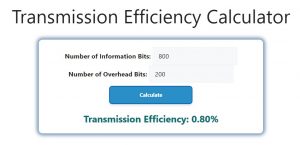About Transmission Efficiency Calculator (Formula)
The Transmission Efficiency Calculator is an essential tool for evaluating the effectiveness of data transmission in communication systems. It measures how efficiently information bits are conveyed over a network compared to the total number of bits transmitted, including overhead. Understanding transmission efficiency is crucial for optimizing data transfer rates, reducing costs, and enhancing the overall performance of communication systems in various applications, such as telecommunications, data networks, and broadcasting.
Formula
The formula for calculating transmission efficiency is as follows:
Transmission Efficiency (Et) = Number of Information Bits (IB) / (Number of Information Bits (IB) + Number of Overhead Bits (OB))
Where:
- Et is the transmission efficiency, expressed as a fraction or percentage.
- IB represents the number of information bits transmitted.
- OB denotes the number of overhead bits added to the transmission.
How to Use
Using the Transmission Efficiency Calculator is straightforward:
- Identify Information Bits: Determine the total number of information bits (IB) that need to be transmitted.
- Determine Overhead Bits: Identify the number of overhead bits (OB) associated with the transmission, which may include error-checking bits, headers, or any additional data required for transmission.
- Input Values: Enter the values for information bits and overhead bits into the calculator.
- Calculate Transmission Efficiency: The calculator will compute the transmission efficiency based on the provided inputs.
Example
Let’s illustrate how to use the Transmission Efficiency Calculator:
- Information Bits (IB): 800 bits
- Overhead Bits (OB): 200 bits
- Apply the Formula:
Using the formula:
Transmission Efficiency (Et) = Number of Information Bits (IB) / (Number of Information Bits (IB) + Number of Overhead Bits (OB))
= 800 / (800 + 200)
= 800 / 1000
= 0.8 or 80%
In this example, the transmission efficiency is 80%, indicating that 80% of the transmitted bits contain actual information, while 20% consist of overhead.

FAQs
- What is the Transmission Efficiency Calculator?
The Transmission Efficiency Calculator assesses how effectively information is transmitted in a communication system, accounting for overhead. - What does transmission efficiency indicate?
It indicates the proportion of useful information transmitted compared to the total bits sent, reflecting the efficiency of the transmission process. - What are information bits (IB)?
Information bits are the actual data bits that represent the message being sent. - What are overhead bits (OB)?
Overhead bits are additional bits required for data transmission, including headers, checksums, and other control information. - How is transmission efficiency calculated?
It is calculated using the formula: Transmission Efficiency (Et) = IB / (IB + OB). - What is a good transmission efficiency percentage?
A transmission efficiency above 80% is generally considered good, though this can vary depending on the application and network conditions. - Why is overhead important in data transmission?
Overhead is crucial for ensuring data integrity and managing communication protocols, though it reduces overall transmission efficiency. - Can transmission efficiency be improved?
Yes, by minimizing overhead bits through efficient protocols and data compression techniques, you can enhance transmission efficiency. - What factors affect transmission efficiency?
Factors include the type of transmission medium, network protocols, data encoding methods, and the presence of error correction. - How does transmission efficiency impact network performance?
Higher transmission efficiency leads to better utilization of bandwidth and faster data transfer rates, improving overall network performance. - Is transmission efficiency the same as bandwidth efficiency?
While related, transmission efficiency focuses on the ratio of useful data to total data, whereas bandwidth efficiency refers to how well the available bandwidth is utilized. - What industries benefit from calculating transmission efficiency?
Telecommunications, data networking, broadcasting, and any field involving data transmission benefit from understanding and optimizing transmission efficiency. - How does packet size affect transmission efficiency?
Larger packet sizes may reduce overhead as the proportion of overhead bits decreases, improving efficiency, but can also lead to increased delay. - What tools can be used to measure transmission efficiency?
Various software tools and network analyzers can measure transmission efficiency and provide insights into network performance. - What role do protocols play in transmission efficiency?
Network protocols determine how data is packaged and transmitted, affecting the amount of overhead and, consequently, the transmission efficiency. - Can the calculator handle variable overheads?
Yes, the calculator can be used for various overhead scenarios by adjusting the overhead bits input. - What is the significance of maintaining high transmission efficiency?
Maintaining high efficiency is crucial for optimizing data flow, reducing latency, and ensuring cost-effective communication. - Is there a relationship between transmission efficiency and error rates?
High error rates can increase the need for retransmissions, increasing overhead and reducing transmission efficiency. - How often should transmission efficiency be measured?
Regular measurement is recommended, especially in dynamic environments where conditions may change frequently. - Where can I find more information on transmission efficiency?
You can find more information in telecommunications textbooks, networking courses, and online resources focusing on data communication.
Conclusion
The Transmission Efficiency Calculator is a valuable resource for anyone involved in data transmission, providing insights into the effectiveness of communication systems. By calculating transmission efficiency, users can identify areas for improvement, optimize data transfer, and enhance the performance of their networks. Understanding this concept is essential for professionals in telecommunications, IT, and related fields, ensuring that data transmission is both efficient and effective.